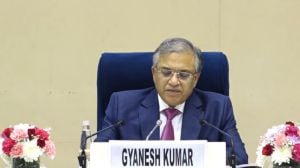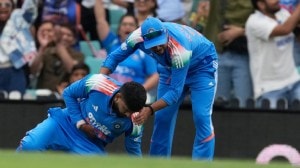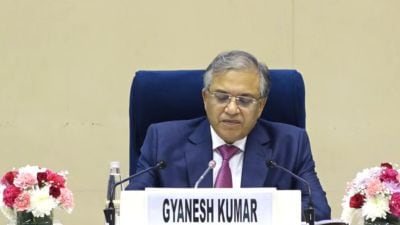‘Devi maa ki puja toh devi hi karegi na’: In break with tradition, women priests lead Durga puja at Delhi’s Greater Kailash 2
Priyanka Chakravarti and Neelanjana Ganguly — the two trained female purohits or priestesses — have come all the way from Kolkata in West Bengal to perform the five-day long Durga Puja rituals within the broader ten-day period of Sharad Navratri.
 Neelanjana (L) and Priyanka at the GK-2 pandal. Express photo
Neelanjana (L) and Priyanka at the GK-2 pandal. Express photoThe aarti is about to begin at the Durga Puja pandal at M Block in Greater Kailash-2 as the Navratri celebrations enter the ninth day on Tuesday. Around 100 devotees gather to witness the ritual. The rhythmic beats of the traditional dhaak fill the air as the drummers take their places. Women, holding dhunuchi (incense burners), sway gracefully to the music, dancing in devotion.
But this year, there’s a powerful break from tradition — instead of a male priest leading the aarti, two women step on the dais to perform the rituals. They begin the prayer with a resounding Ulu dhwani. Their strong, high-pitched calls, echoing through the pandal, mark a moment of reverence and change.
Priyanka Chakravarti and Neelanjana Ganguly — the two trained female purohits or priestesses — have come all the way from Kolkata in West Bengal to perform the five-day long Durga Puja rituals within the broader ten-day period of Sharad Navratri.
‘Devi maa ki puja toh devi hi karegi na’: In break with tradition, women priests lead Durga puja at Delhi’s Greater Kailash 2 | @ankitaup reportshttps://t.co/SXSHXEiDgQ pic.twitter.com/SyPPc5SIVQ
Priyanka (36) is a teacher in West Bengal’s Hooghly district and teaches Sanskrit to students. Ever since she was a child, she has seen her father performing Durga Puja at the Kali Mata temple near her house. “Gradually, I started performing rituals at my home and then at the pandals in Kolkata. This time, we decided to come here to perform the puja,” she says.
Dressed in a green jamdani saree, Priyanka repeats a sentence in Bengali that she often hears from people — “Tumi ki purohit der bhat marbe (Will you rob the purohits of their profession?)”
“It is nowhere written that women can’t perform prayers… anyone with a clean heart can perform prayer for the goddess,” she says, adding that her family and her children are supportive of what she is doing. Visitors at the pandal, she says, have never indulged in any sort of gender discrimination in this regard. In fact, she adds, she is also being approached by people to conduct marriage ceremonies. “We have a group called ‘Kriti’ of 10-12 women priests who perform puja at marriage ceremonies and Durga Puja,” she shares.
Neelanjana (34) is also a member of the group. She says she wanted to learn all about rituals but nobody was willing to teach her. But then, she reached out to Priyanka. An MA in Sanskrit, Neelanjana too teaches the language to children at her home. Both of them have a son each. “Our husbands are very supportive,” says Neelanjana, referring to childcare responsibilities.
Both of them say that this prayer does not require a janeu -dhaarak (one who wears a holy thread), as per widely held beliefs. “Devi maa ki puja toh devi hi karegi na (Goddess will be worshipped by women itself),” they say in unison.
Shoma Mukherjee, organiser of the Dakkhinayan Durga Puja commitee , M block, GK-2, where both the priestesses are leading the prayers, and professor of management, says she has been organising Durga Puja for the last 26 years.
“Last year was our 25th year and we wanted to do something different to commemorate that. My wish was to take women empowerment forward and I had heard about women priests performing puja and marriage ceremonies as well. So I looked around but couldn’t find anyone in Delhi but got one in West Bengal,” she adds.
She got in touch with Nandini Bhowmik who trains women as priestesses and she has another group of 12-14 women priestesses.
“We believe in women power and the majority of our members are women. So, we finally got Priyanka and Neelanjana to perform prayers for us this year,” says Shoma.
She says that the way both the priestesses pronounce the mantras is entirely different from what she is used to hearing.
“We were surprised by the way they deliver the mantras and explain the things. They are highly educated and they are trained purohits,” says Shoma.
However, the change has come with a lot of challenges . “The mindset is that the women don’t have janeu so they can’t perform these rituals. But we have had a number of women priests. In our ancient Vedic times, we have had women scholars like Gargi and Maitreyi. So, we are breaking from the tradition, and including female priests to perform our annual Durga Puja,” she adds.
Malayendu Mukherjee, a retired Indian Air Force officer and a member of the Dakkhinayan Durga Puja organising committee, shares his experience. “Goddess Durga being worshipped by two young women priests — this is the idea and we want the whole nation to know…” he says.
According to Malayendu, they are the only female priests in the Capital. “We only talk about women power but we wanted the women to come forward and the young generation should see. Women are doing everything… so why not puja, why restriction on Puja. People came up to me and said that they don’t have janeu but so what? The young generation must see this. Now I am also getting enquiries for them by people who want their children to get married by a female priest. I have already got two bookings for January,” he adds.







